

![]()
Waiting for students' attention
I've been sharing at seminars the idea that it makes more sense--in a long-term, eyes-on-the-horizon, anticipate-a-better-classroom-culture kind of way--to condition the students to come to attention on their own.
The Old School mindset has been for the teacher to begin speaking even though not everyone was listening. I'm guessing that the teacher was most likely thinking, "When the students hear my voice, they'll stop their side conversations and pay attention to what I'm saying."
Sadly, though, when the teacher speaks before having everyone's attention, the students learn a far different lesson.
I don't have to come to attention on my own.
I can sit out here and chit-chat until the teacher starts talking.
I don't have to be aware of the classroom environment.
I don't have to assess what's going on around me.
And if the teacher continues to talk even though some students are still engaged in social side bars, another lesson is learned.
The teacher is going to talk whether I'm listening or not,
so I guess I don't really need to listen.
Whereby the whole thing slowly spins out of control as more and more students disengage from the lesson.
What's a concerned educator to do?
Do what I've always done: condition your students to come to attention on their own.
- Stand in front of your class in a calm, assertive manner.
- Look for students who are paying attention and silently acknowledge them.
- Avoid the temptation to speak or utter any words.
- When everyone is finally with you, thank them for their attention.
Although it takes what seems like forever the first couple of times you try this strategy, before too long you'll be able to stand in front of your class and have everyone's attention wtihin fifteen seconds.
And for the remainder of the year, that's how it will go.
If, on the other hand, you do the Old School thing and call for their attention, you'll be doing that all year long.
The choice is yours.
Just be prepared for your students to test your patience at first. Especially the older students who have spent years being conditioned to check out until some adult shouts them into submission. It's going to take longer for them to adjust as opposed to first or second graders who are relatively new to classroom cultures. But adjust they will if you are able to hold them accountable for their non-compliance.
Accountability
At two seminars this past week, which were follow-up sessions, I asked if anyone had tried the "wait for their attention" strategy. I heard a lot of, "I tried it and it worked really well." I also heard, "I tried it in a continuation high school setting and it was a bust."
Success and failure. That's to be expected with any teaching technique since one size does not fit all.
I also heard secondary teachers--one from each seminar--share the accountability piece they added to the procedure.
The first one said:
"While I'm waiting, I look at the clock. This helps to remind them that they're wasting time. The time they waste is paid back at the end of the period. When the bell rings, I make them wait however long they made me wait."
The other one announced:
"I had to wait twenty minutes for one class to finally come to attention. I was okay with that because I only had to do it once and they got the message. That's because I made everyone return to my room for seventh period to hear the part of the lesson I hadn't be able to present due to the wasted time."
Tip o' the hat for holding students accountable for their behavior.
However, what about the students who were being attentive from the git-go? The ones who were paying attention as soon as the bell had rung. Do they have to pay the same price as their wayward brethren?
If so, you're going to foment dissension in the ranks. Blasting everyone for the actions of a few--an Old School standard--will cause students to either become angry with you or angry with their non-compliant classmates. Neither of these emotional responses will help foster that oh-so-critical positive classroom culture.
Better, I think, to separate the wheat from the chaff. Keep track of which students are coming to attention on their own and which ones aren't. By doing that, you'll be able to show your appreciation for one group of students yet intervene with the other. (Core Principle #4: You can focus your attention.)
How do you determine which is which? With a seating chart.
As you stand in front of the classroom waiting for their attention, have a seating chart on a clipboard in one hand and a pencil in the other. Make a little dot in the seating box of anyone paying attention. Write an "T" for the hard-core social talkers. When you finally have everyone's attention--and this waiting cycle will soon become shorter and shorter as they adjust to the strategy--put the clipboard down and thank everyone for their attention.
At the end of the period, pick up the clipboard. Announce the names of the students you need to see when the bells rings. Ignore their moans or spoken protests. Once the other students have left and you have the chosen few still in their seats, explain why they are being held back. Again, ignore their pitiful attempts to deny culpabiltiy. They're just testing your resolve.
Once you've explained why you held them from leaving on time, remind everyone that you are not the kind of teacher who calls for attention. You might mention that other teachers do but you don't and that they will need to adjust their behavior while in your classroom. (After all, that's the only thing you can influence: their behavior in your room.)
Close with a simple, "What are you going to do tomorrow when you see me waiting at the front of the room?"
They should respond with some kind of mumbled, half-hearted, "Pay attention."
"That's all I'm looking for. Have a great day."
And with that, they are dismissed. Total time: 30 seconds or less. Just enough to make a point that you are serious about their self-control. Because when it comes to holding students accountable, always remember action is thing that will convince them of your conviction.
Closing thought
After sharing this idea at both seminars, the teacher who had his students return to seventh period said, "I remembered who had been paying attention and excused them from having to make up the lost time."
Good for you and good for them. But what about the missing lesson?
Ah, it's never easy.
![]()
ESGIsoftware.com
(feature piece in their February, 2009 newsletter)
ESGI makes some great software for getting a handle on record keeping during guided instruction. Every month they produce a newsletter with tips, resources, conference information, and a feature about someone in education. And for March that someone was me.
Although the newsletter is not posted on their web site--it's distributed by email to teachers on their mailing list--I'll include the idea they used for their monthly Teacher Tip which they lifted from my own Teacher Tips page.
"Could You Do a Sample?"
This is a phrase I taught my students to use because, for the most part, students don't know how to ask for help. This is especially true when you're in the middle of a lesson and one of your students is confused about something.
Confused Student
I don't get it!I've heard this quite a bit over the years, and I always responded in the same, predictable Old School way. (It was a response my own teachers had used and, as a consequence, had become a part of my classroom lexicon.)
Mr. Morris
What don't you get?Confused Student
More confused than ever and now thinking:
.....Is he asking me to explain what I don't get? Hey, if I could explain it, I'd understand it.....
Spoken aloud with a touch of frustration:
"I JUST DON'T GET IT!"When I eventually realized that "What don't you get?" was an ineffective response, I came up with a better way to go.
I taught my students to ask for a sample.
After explaining when to use the phrase and exactly what it means, it still takes about a month or so for them to develop the habit of using it. To help them along, I'll take the lead.
Mr. Morris
Seeing that some of my students are looking at their neighbors for clarification about what I had just said to everyone:
If you'd like a sample, just ask.Confused Student
Could you do a sample, please?What student is really saying is:
Hey, Mr. Morris. Stop talking. Your words are doing me no good.
Could you model what you're talking about.
Could you draw what you're talking about.
If it's a written assignment you're asking us to do, could you show me what
it's supposed to look like?
Could you have students demonstrate what you're talking about?
Because if you just repeat what you already said, I'm still going to be confused.
Here's the beauty of "Could you do a sample, please?" It's safe language. It doesn't mean the student is stupid. It doesn't mean he wasn't paying attention. It doesn't mean he wasn't trying hard. It just means that he would like the information to be presented in a different way than it had already been presented.
Mr. Morris
Happy to do a sample. Thanks for asking.This will, of course, cause you to have to stretch a bit as a teacher. You'll have to learn how to present information in more than one way. But that's okay. The more you do it, the better you'll get. And the better you get at teaching, the more your students will get out of your lessons and the less they'll ask for a sample. It's the classroom version of the circle of life.
Note: This phrase is one of the Top Ten Things I say as described in the book, Eight Great Ideas. And although it's not actually something I say, I thought the language was important enough to include in the Top Ten.
![]()
Kindergarten students share pictures with the teacher
We were talking about the fact that during our literacy block I meet with small groups of students. And although I've made it clear that we are not to be disturbed, some students will try to come up to the table to share what they think is an incredibly important need. The solution--or, the way I learned to redirect that energy--was to have them write their concerns or questions on post-it notes and then stick the note on the reading table next to where I'm sitting. I can then look down, read the note, read the name of the student who wrote the note, and make a determination about whether I should deal with the issue right away or wait until the small group meeting is over.
Upon hearing this idea, a kindergarten teacher in the group offered a slight variation on this idea.
Kindergarten Teacher (during a seminar break):
I made small pictures of different possible student needs or concerns, made xerox copies of the pictures, and then cut them apart. Even though my students can't put their concerns in writing, any student can pick up the picture that represents his concern, write his name on it, and lay it next to where I'm working.
Nicely done.
Birth of a Notion
I'm going to write about my experience using a brand new idea, the Page Pen. It's a goofy little idea that is actually a lot of fun to use.
I thought it might be helpful if I were to provide an inside look at the problem-solving strategies I employed during the course of a seminar as I worked at refining and improving the initial concept.
Genesis
If you've been to one of my seminars, you know that almost all of the ideas I've created over the years have come about through problem solving. It's not that I'm trying to be clever or novel but more that I'm trying to make the classroom an easier place in which to live.
Problem to Be Solved
What's the best way to communicate a page number to a group of students?
I know what the easy thing to do is: verbally announce the page number you'd like your students to find. But just because it's the easiest doesn't mean it's the best.
There are already enough words being spoken by the teacher without adding to the body count by saying something along the lines of, "Okay, I'd like everyone to turn to page 78 in your social studies book."
If you think about it for a moment, you'll realize that the only critical info being shared in the statement above is "page 78." (We're going to assume that the social studies book is already out and accessible.) Everything else is just blah, blah, blah.
So, if I only need to share the actual page number, why not write it on the board? Not only will this eliminate unnecessary words from the teacher, it will also eliminate unnecessary questions from the students.
"What page did you say?"
"Huh?"
"What page?"
(Supply your own annoying question here.)
And that's what led to the creation of the Page Pen: a whiteboard marker I'm going to use during seminars to indicate which page in the seminar guide I'd like the teachers to find.
First Attempt
I introduced the idea to the group that day and showed them where I was going to write the page number.
It was a dedicated space on the whiteboard directly behind me. The nearness of the board was going to make it easy for me to write new page numbers throughout the day. And, as I learned during my days of classroom teaching, ease-of-use is critical to the success of just about any new idea.
However, just writing the page number was not going to be enough. I was going to need some way to draw the group's attention to the fact that I had just written a new page number on the whiteboard. Being a true believer in the power of sounds as effective communication vehicles, I quickly realized that I needed a sound to send a message that meant, "Look at the new page number I just wrote on the board and turn to that page, please."
I looked through my suitcase of tools and toys that I always have with me during seminars.

There were quite a few sound makers from which to choose.
- Hotel bell
- Dog squeak toy
- Train whistle
- Dog clicker
- Cow bell
- Jingle bell bracelet
- Slide whistle
- Musical chime
- Bicycle horn
- Bicycle bell
The first three choices on the list were no good. I had planned to introduce them during the day as sound makers I used over the years and didn't want to confuse anyone by using them for something other than what I had used them for in the classroom.
- Hotel bell (passing out materials)
- Dog squeak toy ("Stop, look, listen.")
- Train whistle (students line up outside)
The jingle bell bracelet seemed like a reasonable choice. It was loud enough to be heard and was somewhat easy to use. By that I mean it only took one hand to use. The slide whistle, which produces a great sound, requires two hands to use; not good if I'm going to need to produce the sound numerous times.

New Problem to Solve
Where do I place the jingle bell bracelet so that it's convenient?
The simple fix would have been to hang it from one of the hook/clips already attached to the rail above the whiteboard. Unfortunately, the clip wasn't big enough to securely hold the bracelet. It would have been iffy every time I gave it a shake. Is it going to stay or fall? That kind of niggling stress is not something I need during a talk. And so, after giving it a try a time or two and confirming that the pathetic little hook wasn't going to cut it, I decided to make the attachment more secure.
I went back to the suitcase and pulled out a shoelace necklace. (See: Neon Necklace, page 33, in the book Tools & Toys.) I fed one end of the necklace through the bracelet, slipped the other end through the loop, and then pulled it tight.
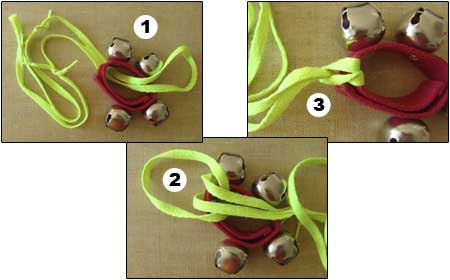
With the "leash" attached to the bracelet, I was able to hang it from the hook without fear that it would fall down. But after using it three or four times, I wasn't happy with my design. It was a bit awkward to write the number on the board, cap the pen, put the pen down, and then reach over and ring the bells. I just knew it could be easier than all that.
Back to the Drawing Board
More than anything, it was the placement of the bells that was buggin' me. They were hanging down from the side of the whiteboard--nowhere near the spot where I wrote the page number--but there didn't seem to be a way to get them any closer.
That's when I thought that maybe I should switch sound makers.
I took the bells down, returned them to the suitcase, and pulled out my trusty little dog obedience clicker.
I've been sharing these at seminars as a more sophisticated attention-getter than the dog squeak toy. Secondary teachers, I've noticed, are somewhat reluctant to use a classroom toy that may seem too elementary schoolish. I'm guessing that this stems more from a natural fear of hearing either derision or rejection from the students than from a lack of desire on the teacher's part to try new ideas. Whatever the reason, good ideas are going unused which is always to be lamented.
The clicker, I thought, would work great if I could attach it to the whiteboard so that it sat right next to the page number spot. Unfortunately, I didn't have any adhesive magnets to stick to the back of the clicker so that it would cling to the magnetic whiteboard. (See: Adhesive Magnet on Attention Clicker)
Even without the magnet, though, a little tape loop on the back so that it would stick to the board for the remainder of the day would allow for a temporary work-around. Then, when I got back home, I could find a magnet and attach it so that it would be ready for subsequent seminars.
But when I held the clicker against the whiteboard to try it out, it didn't work well. The spot on the metal clicker I needed to press was not that easy to hit. It's very easy to do when the clicker is held in my hand but not so easy when it's not in my hand.
Bummer. Now what?
Eureka
And that's when I realized that the ideal solution would be to somehow attach a sound maker to the actual pen so that the sound was produced while the pen was being used to write the number. Oh, yeah. That's the ticket.
Since I had used the jingle bells earlier in the day, my first thought was to hot-glue a single jingle bell to the end of the pen. That thought died a quick death when I realized that when the pen ran dry, the bell glued to it was worthless.
Immediately following the hot glue idea was the thought to just tie the bell to the end of the pen so that it could be removed and attached to a new pen when the need arose. Sadly obvious when you think about it.
And so, at the lunch break, I drove to Michael's Arts & Crafts, and was soon standing in front of the display of bells. (Holy cow. Who knew there'd be so many different types and sizes?) After a bit of decision-making--the bell needed to be big enough so that the sound was distinct and easy to hear--I grabbed a 3-pack of miniature cow bells for less than two bucks.
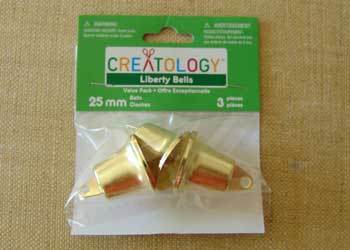
Michael's was out of mini-cow bells when I went back.
These should work just as well.
(Update: not really.)
On my way back to the seminar site, somewhat giddy about the new, improved idea but also contemplating how I was going to attach a bell to the pen, I realized that tying it on with string was not as elegant as using a simple rubber band. In fact, I could thread one end of the rubber band through the eyelet on the bell, poke the other end through the loop, and then pull it tight. (That's right. Just the way I did with the shoelace and the jingle bell bracelet.)
Once the cow bell was securely attached to the rubber band, it was an easy matter to wrap the rubber band around the end of the pen.
Voila!
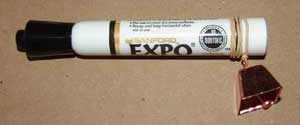
I used the Page Pen for the remainder of the seminar to great effect. Not only did it clearly transmit the page number I wanted everyone to look at, it was easy for me to use. Win-Win.
Caveat
The only difficult part of using the Page Pen was breaking myself of the habit of saying, "Hey. Take a look at page 6." That's not as easy to do as it may seem. After all, I've been announcing page numbers for as long as I've been teaching. Switching over to a new method always takes a bit of time.
In fact, one of the most difficult, but often overlooked, obstacles to incorporating a new idea into our classroom routine is the time it takes for the new idea to become automatic. Once that occurs--and it took me several seminars to develop the Page Pen habit--it's a piece of cake.
![]()
Kaizen
The Japanese word for "continuous improvement" was actualized when I was using the Page Pen a week after its creation. There were some middle school teachers in the group that day and one of them said, "The pen is a nice idea but it's not always a page number I want my students to look at. Sometimes I just want them to take out their planners."
Me
Visualizing the problem for a moment:
I don't see why you couldn't make some small signs and tape them to the whiteboard near where you write the page number. Each sign would indicate an item you want your students to retrieve. Then, when you wanted them to get their hands on something, you could use the pen and place a check mark next to the appropriate sign.
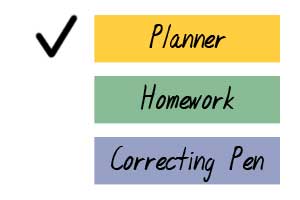
It's like I'm back in the classroom. And that's a sweet thought.
![]()
Closure at the end of the day
As I usually do at some point in a seminar, I shared the research that states, "3 minutes of effective closure can enhance retention by 50 per cent." During the break that followed that thought, a teacher came up to me to share how she and her students deal with closure at the end of the day.
Teacher:
I have my students spend the last fifteen minutes of each day writing entries about what they each learned that day in their Learning Logs. It's always been a nice way to end the day. I'm just wondering if that's the best way to do closure.
Well, any closure is better than no closure. And as much as I like the idea of students maintaining a journal of what they're learning, I'm not so sure that waiting until the end of the day to do it all is the best way to go.
Imagine if you were given an evaluation form at the beginning of an all-day workshop on teacher effectiveness. What would produce a more accurate picture of what you learned that day?
Recording a thought every hour.
Recording all of your thoughts at the end of the day.
I don't know about you, but I'm thinking a regularly scheduled entry would be better than trying to reflect back on the entire day when the session is over.
With that thought in mind, I recommended that she think about the possibility of not waiting until the end of the day to do all of the entries. That maybe her students could make short entries at the conclusion of the various learning activites and then be allowed to use the last 10 to 15 minutes to share with the class what they had recorded.
Not only would this be a more manageable way for underachievers to create a complete picture of what they had learned, they'd also have the ability to add entries as they heard their classmates share theirs. This would be possible, of course, because they would have already written the bulk of their observations before the actual sharing began.
Core Principle #5 states that your classroom is manageable for everyone. Writing a series of short entries while the info is fresh is more manageable that having to write them all as the day is drawing to a close.
![]()
Teacher stood when repeating
I was working with a large group of teachers in a somewhat noisy cafeteria. During a discussion, one of them offered her opinion on something. Right away, another teacher called out, "Echo!" (This is the strategy explained in Chapter 3 of the book Eight Great Ideas. The chapter is called, "Confessions of a Former Echoer." It just means that the person who said "Echo" hadn't heard what the speaker had just said.)
Anyway, the teacher repeated what she had just said but--being in an acoustically challenging environment--her voice didn't carry very well. Once more, a teacher called out, "Echo!"
At the sound of the second "Echo," the teacher stood up, turned toward the area of the room from which came the request, and repeated her original statement. Because she had stood to project her voice, her original statement was delivered.
Wow. That's exactly what would have happened in my room whenever a student heard "Echo" more than once. The student would finally stand and deliver. It sometimes took a sign language prompt from me; but, they eventually learned to do it on their own.
It was great to see the same dynamic--without the need for a prompt--play out during the course of a presentation.
![]()
Voice used for dismissal from carpet
Teacher (during a seminar):
I know it's usually better to use a sound or a song to initiate a procedure we have to do over and over again. However, it seems a bit unnecessary to do that when I'm releasing from a carpet meeting when I can just use my voice. Having to walk over to the CD player and find the right song seems like a bit of a hassle.
I responded by stating that if the CD player is not convenient to use, it's not likely to be used. Maybe, I suggested, you could put the player in an easy-to-get-to spot. After all, using musical cues to initiate a procedure is usually better than using your voice.
My bad. I should have said, "Go ahead and use your voice to dismiss them. They're right there in front of you and you have their attention. Your voice is fine in that situation."
It's when they're at their desks--in who knows what kind of attention state--and you want to call them to the carpet that a distinctive sound or song should be used. Dismissing them when you're done, on the other hand, can be as simple as, "Okay, guys. That's a wrap. Back on task."
![]()
Learning journals as closure activities
After coming back from the first break, I showed a slide that talked about the effectiveness of closure in enhancing student retention of information.

I then asked the teachers in the group that day to come up with what they thought might be effective closure activities. Among a number of suggestions, one of the teachers offered this idea: Have your students record what they learned in a "learning journal."
Wow. What a great idea. (Thanks, Scott.)
![]()
The Check Off Sheet revisited
In a post on the Thoughts on Class Cards page, Class Cards and reciprocal teaching--I talked about calling upon teachers to respond to my question: "Which student should I go see right now?"
We were discussing the information provided by the math Check Off Sheet.
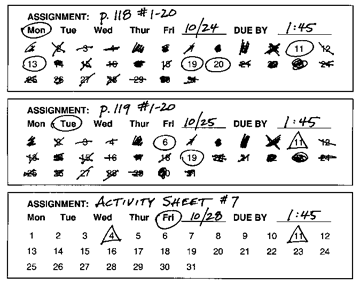
I was running through the same interaction as before, i.e., calling upon teachers to respond to my question and then putting their cards in separate piles based upon their responses.
Although I was pleased to see how many teachers knew that I should be talking to Marshall, #19, there were still a couple of them who thought I should be talking with Fabian, #11. That's just how it goes.
Anyway, I'm happy to report that I was able to apply the lesson I learned during my interactions with the teachers in Los Angeles to the teachers in today's group. After calling upon about ten of them, I returned to someone who had answered correctly. And it was this person who was the one to teach the lesson about knowing it was Marshall we should be seeing since his number was circled on both Monday and Tuesday. This teacher was also able to explain that the reason we couldn't see Fabian was because he is currently absent. Ah, much better than me doing it all.
In fact, I'm now realizing that having a teacher do the teaching can be extremely beneficial to the involvement of the others in the group. If I had been the one to explain the whole Marshall-is-circled-and-Fabian-is-triangled routine, it would have seemed natural. After all, I was the "expert" and have been using this New Management system for years. Therefore, it would not be too troubling to those in the group who didn't understand the material as well as Rick Morris does. Come on, they're thinking. He lives this stuff, I don't.
However, if I'm a member of the audience and one of my colleagues was able to figure out how to decipher the Check Off Sheet, then maybe I'm thinking I should have been able to do the same thing and maybe, just maybe, I'll become a bit more engaged in what's going on.
Just a thought.
